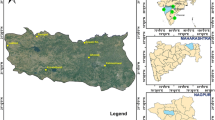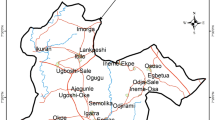Abstract
In current scenario, the groundwater resources are gaining much attention due to enhanced demand of rising population, urbanization, agricultural expansion, etc. The groundwater condition in hard rock terrain, specifically in Deccan trap basaltic region of Maharashtra state, is highly uncertain due to anisotropic aquifer system. In addition, high evaporation and run-off limits the natural recharge to the groundwater. Therefore, the unsustainable distribution of water from the dug wells and bore wells in basaltic region is common which altogether results in acute scarcity of drinking water in the event of drought. In order to mitigate this situation the state groundwater departments often resorts to tapping of deeper aquifers to meet the drinking water demand. However, it is found that the percentage of high yielding borewells is very low due to anisotropic hydrogeological condition of basaltic terrain, and also due to lack of primary porosity unlike sedimentary formations. In view of this it is pertinent to understand the role of lineaments and fractures on the yield of the borewells, as the lineaments i.e. weaker zones, plays vital role in groundwater movement. The current study focuses on the influence of lineaments on groundwater regime in hard rock areas by employing the remote sensing technique. For this study the WRWB-2 watershed of the district of Nagpur, Maharashtra, Central India has been investigated. The aim of the study is to understand the importance of lineament mapping in groundwater prospecting. The satellite image of the area was studied to decipher the geomorphological setup and lineament fabrics through visual interpretation. The study area is characterized by basaltic hard rock which forms the multiple aquifer system, wherein wide variations in yield of the borewells are expected. Under this situation the controlling factors such as geomorphological set-up and lineament fabrics have been analysed with respect to yield of the borewells. The overall study revealed that the yield of the borewells tapping deeper aquifers are highly influenced by presence of lineaments as out of the total 143 borewells, 30 are very high yielding with yield >4500 l/h, which is uncommon in Deccan trap terrains. The study demonstrates utility of lineament mapping in the hard rock regions mainly to target productive aquifer system. The decision maker, therefore, should use this technique for successful harnessing of potential groundwater pockets in hard rock areas to achieve the sustainable groundwater availability.
Access this chapter
Tax calculation will be finalised at checkout
Purchases are for personal use only
Similar content being viewed by others
References
Adhikary, P. P., & Dash, C. J. (2017). Comparison of deterministic and stochastic methods to predict spatial variation of groundwater depth. Applied Water Science, 7(1), 339–348.
Arulbalaji, P., Padmalal, D., & Sreelash, K. (2019). GIS and AHP techniques based delineation of groundwater potential zones: A case study from Southern Western Ghats, India. Nature Scientific Reports, 9, 2082. https://doi.org/10.1038/s41598-019-38567-x
Barker, R., Rao, T. V., & Thangarajan, M. (2001). Delineation of contaminant zone through electrical imaging technique. Current Science, 81(3), 277–283.
Chowdhury, A., Jha, M. K., & Chowdary, V. M. (2010). Delineation of groundwater recharge zones and identification of artificial recharge sites in West Medinipur district, West Bengal, using RS, GIS and MCDM techniques. Environment of Earth Science, 59, 1209–1222.
Dar, I. A., Sankar, K., & Dar, M. A. (2011). Deciphering groundwater potential zones in hard rock terrain using geospatial technology. Environment Monitoring and Assessment, 173(1), 597–610.
Das, B., Pal, S. C., Malik, S., & Chakrabortty, R. (2019). Modeling groundwater potential zones of Puruliya district, West Bengal, India using remote sensing and GIS techniques. Geology, Ecology, and Landscapes, 3(3), 223–237.
Edet, A. E., Teme, C. S., Okereke, C. S., & Esu, E. O. (1994). Lineament analysis for groundwater exploration in Precambrian Oban Massif and Obudu Plateau, SE Nigeria. Journal of Mining and Geology, 30(1), 87–95.
Gopinath, G., & Seralathan, P. (2003). Evaluation of aquifer parameters for Muvattupuzgha River Basin, Kerala. Hydrology Journal, 26(4), 53–64.
GSDA. (2008). Groundwater surveys and development agency annual report for the year 2008. Nagpur: District Office.
Gustavsson, M., Kolstrup, E., & Seijmonsbergen, A. C. (2006). A new symbol and GIS based detailed geomorphological mapping system: Renewal of a scientific discipline for understanding landscape development. Geomorphology, 77(1–2), 90–111.
Gyoo-Bum, K., Jin-Yong, L., & Kang-Kun, L. (2004). Construction of lineament maps related to groundwater occurrence with ArcView and Avenue scripts. Computer and Geosciences, 30, 1117–1126.
Hajkowicz, S., & Collins, K. (2007). A review of multiple criteria analysis for water resource planning and management. Water Resources Management, 21(9), 1553–1566.
Indhulekha, K., Mondal, K. C., & Jhariya, D. C. (2019). Groundwater prospect mapping using remote sensing, GIS and resistivity survey techniques in Chhokra Nala Raipur district, Chhattisgarh, India. Journal of Water Supply: Research and Technology-Aqua, 68(7), 595–606.
Kamal, A. S. M. M., & Midorikawa, S. (2004). GIS-based geomorphological mapping using remote sensing data and supplementary geoinformation: A case study of the Dhaka city area, Bangladesh. International Journal of Applied Earth Observation and Geoinformation, 6(2), 111–125.
Kim, G. B., Lee, J. Y., & Lee, K. K. (2004). Construction of lineament maps related to groundwater occurrence with Arcview and Avenue TM scripts. Computers and Geosciences, 30, 1117–1126.
Krishnamurthy, J., Venkatesa Kumar, N., Jayaraman, V., & Manivel, M. (1996). An approach to demarcate ground water potential zones through remote sensing and a geographical information system. International Journal of Remote Sensing, 17, 1867–1884.
Kulkarni, H., Deolankar, S. B., Lalwani, A., Joseph, B., & Pawar, S. (2000). Hydrogeological framework of the Deccan basalt groundwater systems, west-central India. Hydrogeological Journal, 8, 368–378.
Lamas, M. R., & Santos, P. (2005). Intensive groundwater use: Silent revolution and potential source of social conflicts. Journal of Water Resources Planning and Management, 131(5), 337–342.
Mabee, S. B., Hardcastle, K. C., & Wise, D. U. (1994). A method of collecting and analyzing lineaments for regional-scale fractured-bedrock aquifer studies. Ground Water, 32(6), 884–894.
Madrucci, V., Taioli, F., & De-Araujo, C. C. (2008). Groundwater favorability map using GIS multicriteria data analysis on crystalline terrain, Sao Paulo State, Brazil. Journal of Hydrology, 357(3–4), 153–173.
Maggirwar, B. C., & Umrikar, B. N. (2011). Influence of various factors on the fluctuation of groundwater level in hard rock terrain and its importance in the assessment of groundwater. Journal of Geology and Mining Research, 3(11), 305–317.
Mehr, A. J., Laghate, S. A., & Patel, R. K. (1989). Description of lineaments found in Kalaved Taluka of Jamnagar district and drinking water supply. In: International workshop on appropriate methodology for development and management of groundwater resources in developing countries, Oxford and IBH Pub. Co. Pvt. Ltd., Vol. 1, pp. 311–314.
Nag, S. K. (2005). Application of lineament density and hydrogeomorphology to delineate groundwater potential zones of Baghmundi block in Purulia district, West Bengal. Journal of Indian Society Remote and Sensing, 33(4), 522–529.
Naik, P. K., & Awasthi, A. K. (2007). Estimation of shallow aquifer from large-diameter wells in Basalts. Journal of Geological Society of India, 69, 949–958.
Odeyemi, I. B., Malomo, S., & Okufarasin, Y. A. (1985). Remote Sening of rock fractures and groundwater development success in parts of southwestern Nigeria. Natural Resources Forum, 9(4), 311–315.
Pande, C. B., Moharir, K. N., & Pande, R. (2018). Assessment of morphometric and hypsometric study for watershed development using spatial technology—A case study of Wardha river basin in the Maharashtra, India. International Journal of River Basin Management, 4(4), 1–36.
Ritchie, J. C., & Rango, A. (1996). Remote sensing applications to hydrology: Introduction. Hydrological Science Journal, 41(4), 429–431.
Sander, P. (2007). Lineaments in groundwater exploration: A review of applications and limitations. Hydro-Geological Journal, 15, 71–74.
Saraf, A. K., Choudhury, P. R., Roy, B., Sarma, B., Vijay, S., & Choudhury, S. (2004). GIS based surface hydrological modelling in identification of groundwater recharge zones. International Journal of Remote Sensing, 25, 5759–5770.
Sener, E., Davraz, A., & Ozcelik, M. (2005). An integration of GIS and remote sensing in groundwater investigations: A case study in Burdur, Turkey. Hydrological Journal, 13(5), 826–834.
Senthilkumar, M., Arumugam, R., Gnanasundar, D., Thambi, D. S. C., & Sampath Kumar, E. (2015). Effects of geological structures on groundwater flow and quality in hardrock regions of northern Tirunelveli district, southern India. Journal of Earth System Science, 124(2), 405–418.
Singh, L. K., Jha, M. K., & Chowdary, V. M. (2017). Multi-criteria analysis and GIS modeling for identifying prospective water harvesting and artificial recharge sites for sustainable water supply. Journal of Cleaner Production, 142, 1436–1456.
Sreedevi, P. D., Subrahmanya, K., & Ahmed, S. (2005). Integrated approach for delineating potential zones to explore for groundwater in the Pageru River basin, Cuddapah District, Andhra Pradesh, India. Hydrological Journal, 13(3), 534–543.
Srivastava, P. K., & Bhattacharya, A. K. (2006). Groundwater assessment through an integrated approach using remote sensing, using remote sensing, GIS and resistivity techniques: A case study from a hard rock terrain. International Journal of Remote Sensing, 27(20), 4599–4620.
Varade, A. M., Khare, Y. D., Dongre, K. P., Muley, S., & Wasnik, G. (2017a). Integrated geographical information system (GIS)-based decision support system (DSS) approach to identify the site-specific water conservation structures in a watershed of Nagpur district, Cental India. Sustainable Water Resources and Management, 3, 141–155.
Varade, A. M., Khare, Y. D., Kolte, D. M., Yadav, P., & Thakur, N. G. (2017b). Significance of lineaments on the groundwater regime of a Basaltic Terrain: A case study of watershed from Nagpur District, Central India. Sustainable Water Resources and Management, 3(1), 41–53.
Varade, A. M., Khare, Y. D., Mondal, N. C., Muley, S., Wankawar, P., & Raut, P. D. (2012). Identification of water conservation sites in a watershed (WRJ-2) of Nagpur District, Maharashtra using geographical information system (GIS) technique. Journal of India Society of Remote Sensing, 41(3), 619–630.
Varade, A. M., Khare, Y. D., Yadav, P., Doad, A. P., Das, S., Kanetkar, M., & Golekar, R. B. (2018). ‘Lineaments’ the potential groundwater zones in hard rock area: A case study of Basaltic Terrain of WGKKC-2 Watershed from Kalmeswar Tehsil of Nagpur District, Central India. Indian Society of Remote Sensing, 46(4), 539–549.
Varade, A. M., Lamsoge, B., Dongre, K. P., Shende, R., & Rajput, A. (2014). Efficacy of Kumarswamy method in determining aquifer parameters of large-diameter Dugwells in Deccan Trap Region, Nagpur District, Maharashtra. Journal of Indian Geophysical Union, 18(4), 461–468.
Varade, A. M., Wadwekar, M., Kolte, D., Dongre, K. P., & Khare, Y. D. (2011). Appraisal of groundwater situation in and around Nagpur city of Maharashtra, using integrated approach of remote sensing & GIS. Gondwana Geological Magazine, 26(2), 129–138.
Varade, A. M., Wath, P., Dongre, K. P., Khare, Y. D., & Khandare, H. (2011). Integrated approach using remote sensing & GIS for assessment of groundwater situation in parts of Chandrapur and Gadchiroli Districts of Maharashtra. Journal of Indian Geophysical Union, 15(4), 195–206.
Zakir, F., Qari, M., & Mostfa, M. (1999). A new optimsing technique for preparing lineament density maps. International Journal of Remote Sensing, 20, 1073–1085.
Author information
Authors and Affiliations
Corresponding author
Editor information
Editors and Affiliations
Rights and permissions
Copyright information
© 2021 Springer Nature Switzerland AG
About this chapter
Cite this chapter
Varade, A.M. et al. (2021). Investigation of Lineaments for Identification of Deeper Aquifer Zones in Hard Rock Terrain: A Case Study of WRWB-2 Watershed from Nagpur District, Central India. In: Adhikary, P.P., Shit, P.K., Santra, P., Bhunia, G.S., Tiwari, A.K., Chaudhary, B.S. (eds) Geostatistics and Geospatial Technologies for Groundwater Resources in India. Springer Hydrogeology. Springer, Cham. https://doi.org/10.1007/978-3-030-62397-5_14
Download citation
DOI: https://doi.org/10.1007/978-3-030-62397-5_14
Published:
Publisher Name: Springer, Cham
Print ISBN: 978-3-030-62396-8
Online ISBN: 978-3-030-62397-5
eBook Packages: Earth and Environmental ScienceEarth and Environmental Science (R0)




